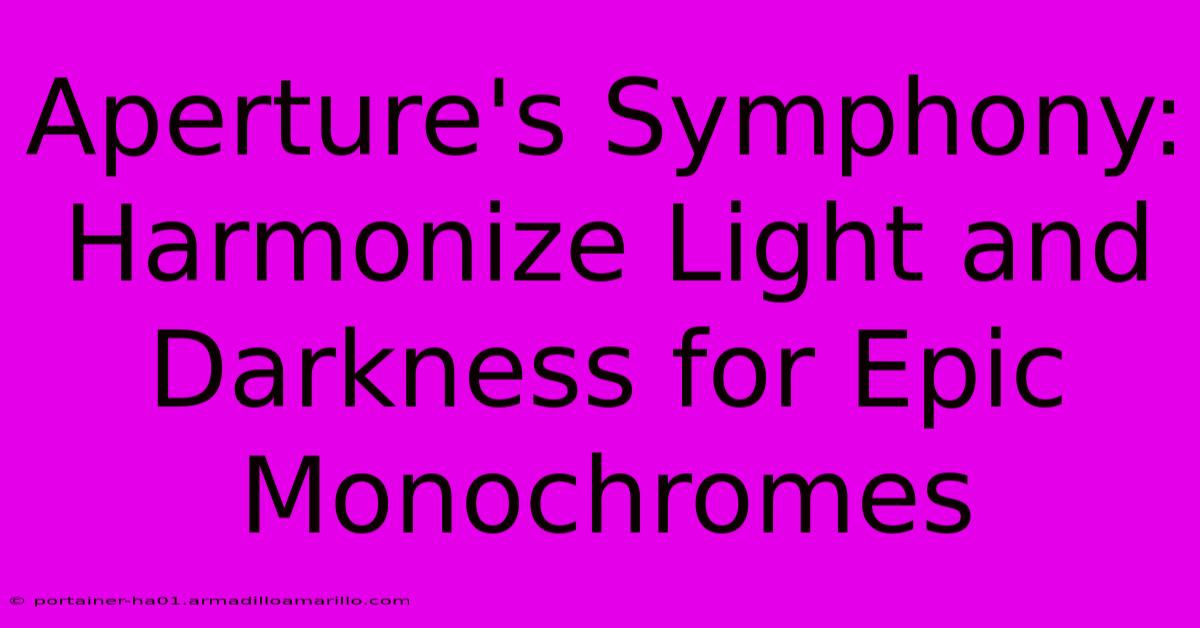Aperture's Symphony: Harmonize Light And Darkness For Epic Monochromes

Table of Contents
Aperture's Symphony: Harmonize Light and Darkness for Epic Monochromes
Monochrome photography. The very words evoke a sense of timeless elegance, a stark beauty that transcends color. But creating truly epic monochrome images isn't about simply desaturating your photos; it's about orchestrating a symphony of light and shadow, a careful dance between brightness and darkness to achieve breathtaking results. This guide delves into the art of mastering aperture in monochrome photography, unlocking the secrets to capturing stunning images that resonate with power and emotion.
Understanding the Role of Aperture in Monochrome
Aperture, controlled by your camera's f-stop setting, dictates the size of the opening in your lens. This directly impacts depth of field – the area of your image that appears in sharp focus. In monochrome, skillful aperture control becomes even more crucial because we lose the color information that can sometimes mask imperfections or lack of depth.
Wide Apertures (Low f-numbers, e.g., f/1.4, f/2.8):
- Shallow Depth of Field: Ideal for isolating subjects, blurring backgrounds, and creating a dreamy, painterly effect. This technique draws the viewer's eye directly to the sharp, focused elements. Perfect for portraits or close-up shots where you want to emphasize texture and detail.
- Bokeh: Wide apertures often produce pleasing bokeh (the aesthetic quality of the out-of-focus areas), adding another layer of visual interest to your monochrome compositions.
Narrow Apertures (High f-numbers, e.g., f/8, f/16):
- Large Depth of Field: Keeps more of your image in sharp focus, suitable for landscapes, architecture, or any scene where you want maximum detail from foreground to background. This is especially effective in monochrome as it allows for a greater appreciation of textural contrasts.
- Increased Sharpness: Often results in a crisper, more defined image, highlighting fine details and subtle tonal variations within the monochrome palette.
Mastering Light and Shadow for Monochrome Magic
The interplay of light and shadow is the heart of compelling monochrome photography. Without color, tonal range becomes your primary tool for conveying mood, texture, and emotion.
Harnessing Contrast:
- High Contrast: Creates a dramatic, almost graphic look. This is achieved by utilizing strong backlighting, side lighting, or strategically placed light sources to create stark shadows and bright highlights. Think strong silhouettes against a bright sky, or sharply defined textures in close-up shots.
- Low Contrast: Generates a softer, more subtle mood. This can be achieved through diffused lighting, overcast skies, or by shooting during the golden hour (sunrise and sunset) for a gentler transition between light and shadow.
Exploring Different Lighting Conditions:
- Hard Light: Creates strong shadows and deep contrasts, ideal for capturing dramatic textures and shapes.
- Soft Light: Produces a gentler, more even illumination, minimizing harsh shadows and resulting in a more subdued, elegant feel.
Post-Processing for Enhanced Monochrome Impact
While in-camera techniques are crucial, post-processing can elevate your monochrome images to a whole new level.
- Black and White Conversions: Explore different conversion methods in your editing software (e.g., Adobe Lightroom, Capture One). Some methods offer more control over individual tonal ranges.
- Tonal Adjustments: Fine-tune the contrast, highlights, shadows, and blacks to achieve the desired mood and impact. A subtle shift in these settings can drastically alter the overall feel of your image.
- Local Adjustments: Use tools like brushes and gradients to selectively adjust the tones in specific areas of the image, further refining the contrast and emphasizing key elements.
Conclusion: Your Monochrome Symphony Awaits
Mastering aperture in monochrome photography is a journey of exploration and experimentation. By understanding the relationship between aperture, light, shadow, and post-processing, you can create truly epic monochrome images that tell powerful stories and leave a lasting impression. So grab your camera, embrace the absence of color, and let the symphony of light and darkness guide your creative vision. The results will be well worth the effort.

Thank you for visiting our website wich cover about Aperture's Symphony: Harmonize Light And Darkness For Epic Monochromes. We hope the information provided has been useful to you. Feel free to contact us if you have any questions or need further assistance. See you next time and dont miss to bookmark.
Featured Posts
-
Twilights Embrace Explore The Enchanting Purple Of The Night
Feb 07, 2025
-
Astounding Accuracy Dayton Vs Nevada Prediction That Will Leave You Dumbfounded
Feb 07, 2025
-
Transform Your Creative Projects With The Porsche Inspired Font
Feb 07, 2025
-
Attention Creators The Definitive Guide To Optimizing Your Tech News Videos For You Tube Discovery
Feb 07, 2025
-
Breaking Tech News You Tube Channel Exposes Industry Scandals
Feb 07, 2025
